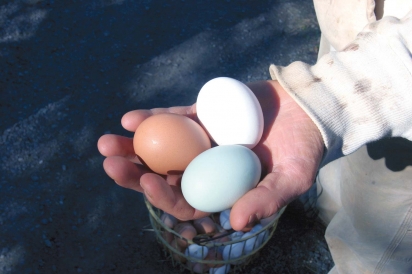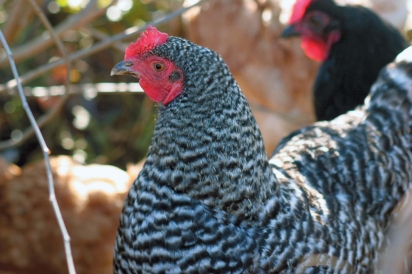Cracking The Code: A Guide to Buying Eggs
Why is buying a dozen eggs so confusing
Cage free. Pastured. Organic. Free range. Certified humane. Natural—What does it all mean? When it comes to eggs, it’s anyone’s guess as to where those chickens have roamed and what sorts of tasty vittles they’ve consumed (or not) before they laid the eggs you’re about to purchase. What impact, if any, does this have on the eggs, not to mention the welfare of the chickens themselves? Whether you’re buying at the grocery store or your local health-food store or farmers’ market, how do you know what’s really in that carton, even when you ask?
It’s a complex issue and the answers can take a consumer on a wild ride, but let’s start with the egg itself. When you crack that farm-fresh egg open into a hot frying pan or see how creamily it fluffs up with a brisk whisking, the egg reveals itself.
“Eggs tell a story, perhaps more than anything else we buy at the farmers’ market,” says Brian Bruno of Apple Ridge Farms, in Saylorsburg, PA. “A cucumber looks like a cucumber—you can’t necessarily tell whether or not it was grown organically just by looking at it, or even by cutting it. But eggs, that’s something else.”
Farm-fresh, pastured eggs exhibit some telltale signs, starting with the shells. For example, brown eggs come from chickens that have brown around their earlobes. Even though they cost more, they’re not nutritionally superior to white eggs. Brown eggs are more expensive because the hens that lay them eat more.
You Are What They Eat
That’s only part of the picture. The yolks of pastured eggs are typically bright yellow or even orange—the best, like Bruno’s, call to mind the color of saffron. This reflects what the chickens have eaten: the deeper the color, the more likely it is that the chickens are spending a good amount of time on pasture outdoors eating whatever they encounter, in addition to their feed.
Bruno typically offers his hens an organic feed that contains soy, corn, kelp meal, brewer’s yeast and a number of other nutrient-dense ingredients that change with the seasons. (At the time of this writing, the feed available contained sunflower seeds, to increase the fat content during the winter.)
This attention to the care and feeding of his hens is one of the reasons why Bruno’s eggs regularly sell out within the first half-hour of any of the nearly dozen farmers’ markets at which he sells them. If a hen’s diet is rich in xanthophylls, those yellow-orange plant pigments surface in the yolks. “But some [bigger] farms know that people look for that, and so they add marigold petals to the feed,” says Bruno.
This results in the same vivid orange hue, but without the outdoor foraging. “Big Ag finds any way of getting on any trend,” he says. Superior nutrition is the goal of Vital Farms, a company whose pastured eggs, culled from more than 100 family farms across the southern United States, are available at local Whole Foods markets. Vital touts the nutritional profile of pastured eggs: They have a third less cholesterol, twice as many omega-3 fatty acids, and significantly more of vitamins A, E and beta-carotene than conventional eggs. (A 2010 study from Penn State came to similar conclusions about pastured eggs.)
Thanks to the increase in fats, pastured eggs also behave better in a pan. “Farm eggs have less liquid in them, so they don’t separate when they hit a hot pan and the whites don’t run all over the place,” says Bruno. Vital Farms spokesperson Dan Brooks says that Vital’s hens forage year-round and are fed a “carefully formulated feed.” He adds, “The taste, texture, creaminess and color of our eggs is affected by what they eat. Grubs can enhance the creamy texture.”
In contrast, conventional hens lay eggs with lighter yolks and watery whites, thanks to the lack of pasture and a feed consisting of corn, wheat, oats and barley. These are the eggs you mostly find in the grocery store for 99 cents a dozen. But chickens are omnivores, meant to eat just about everything from bugs and worms along with feed.
“The secret to good eggs? We used to fence the chickens in, but now we fence them out of where we don’t want them,” he says. So his two flocks have the freedom to roam his seven-acre farm, which is bisected by a small country road. He moves them around the pasture daily. This prevents the soil from becoming too depleted and overloaded with manure, which would be detrimental to the health of the animals.
What’s on the Carton?
Small-scale, regional egg producers with flocks of less than 3,000 laying hens don’t have the same set of rules as larger producers. The Pennsylvania Department of Agriculture regulates the sale of eggs from these flocks, which must be sold within five days and within a 100-mile radius of production. Sometimes an egg carton might say “one dozen unclassified eggs,” because the farms have not weighed them or the eggs are different sizes. An Apple Ridge Farms dozen is a carefully culled mix of colors and sizes from various chickens, including Rhode Island Reds, Barred Plymouth Rocks, White Leghorns, Easter Eggers and Ameraucanas—the latter lay blue, green and pinkish eggs.
Farmers’ markets make conversations between farmers and consumers easy; relationships are the lifeblood of these venues. Bruno would be happy to tell you, for example, why he isn’t interested in organic certification (his farm is certified as natural) or why he doesn’t commingle older birds with newer ones. Supermarkets don’t have such farm liaisons, and many large farms don’t prioritize animal welfare the same way some smaller farms do.
And while a conversation with a farmer will probably answer your questions about those eggs, don’t look to government agencies for clarity at the supermarket.
“The USDA sees its mission as promoting agriculture. Therefore, it has been unwilling to define ‘humane’ as exceeding industry standards. Animal welfare advocates have avoided pressuring the USDA to define ‘humane’ because we are aware that it would likely accept industry baseline standards [which reflect “factory farming” practices] as the definition,” says Dena Jones, director of the Farm Animal Program at the Animal Welfare Institute in Washington, D.C.
For a typical shopper, it’s confusing and murky, isn’t it? But those who know and understand the regulations say otherwise.
“Oh, they’re crystal clear. They have to be,” says Brian Moyer, program assistant for agricultural marketing and entrepreneurship at Penn State Extension Center in Allentown. They may be clear (see sidebar), but there’s a lack of transparency among consumers about what those terms and labels mean.
According to Sam Jones-Ellard, a public affairs specialist in the USDA’s Agricultural Marketing Service (AMS), there’s no industrywide accepted definitions of what “cage-free,” “free range” or “pasture raised” mean, but the AMS has “working definitions built into its policy for officially identified shell eggs. AMS applies these working definitions across all officially identified shell eggs, and verifies these claims through on-farm visits and through identification and segregation plans and procedures at egg packing facilities,” says Jones-Ellard. What the USDA doesn’t have, however, is a legal verification process for the term “pastured,” despite its increase in use.
“It’s used by a lot of smaller farms, but technically, it’s not really allowed,” says Moyer. Dena Jones of the Animal Welfare Institute clarifies it a bit further: “While there is no approval process for the claim of ‘pasture raised’ on shell eggs, there is no law or regulation saying that the claim can’t be used. USDA doesn’t recognize the claim, but use of the claim is not illegal.”
Animal welfare concerns aside, standardizing the term “pastured” is challenging. “There is variation within the industry as to what production practices constitute ‘pastured,’ not only from one company to the next, but from one geographic region to another,” says Jones-Ellard. In other words, the term “pastured” printed on a egg carton tells a buyer nothing.
Ok, so what about organic eggs? Organic certification doesn’t guarantee humane treatment. That’s partly why third-party designations such as “Certified Humane” and “Animal Welfare Approved” have emerged. Vital Farms receives Certified Humane status for its pastured eggs. Each hen receives about 108 square feet of outdoor space. Although the company offers pastured organic, non-GMO and conventional pastured eggs, none of the hens forage on pastures treated with pesticides, herbicides or harmful chemicals, says Brooks. How do you fit that all on a carton?
Regional companies such as Lancaster Farm Fresh Cooperative (LFFC) operate on a middle ground. LFFC runs a CSA and supplies produce and eggs and other farm-fresh goodies to places such as Whole Foods Markets, specialty grocers and health food stores, along with restaurants from Northern Virginia to New York City.
LFFC wholesale manager Adam Barbour says he works with six farms within a 50-mile radius of Lancaster that provide eggs from flocks of approximately 1,000 birds per farm. Their grey cartons contain the phrases “pastured hens,” “hormone free” and “antibiotic free.” All of their eggs perform like you’d expect a local pastured egg to and are from hens that eat non-GMO feed, but that crucial information isn’t on the carton. (If you purchase their organic eggs, there are no GMOs in those.) Barbour says they’re working on a carton redesign.
Label designs for grocery-store eggs have become increasingly pastoral, with images of chickens roaming a pasture. “Lots of times these eggs come from farms where the hens are all in a giant house with a second-floor balcony that can fit like five of them at one time, and that’s their access to the outdoors. It may be free range and organic; it’s still a million chickens in a henhouse,” says Bruno.
Why Are Farm-Fresh Eggs So Expensive?
Pastured eggs are more costly because the birds require more space to roam, and that space means more work for farmers. Bruno goes on an egg hunt every morning, because hens won’t all necessarily lay in one of his two henhouses. They lay wherever they feel like it, even if that means eggs wedged in among random rusty farm equipment in a shed.
Pastured hens are more susceptible to predators such as hawks and foxes, so farmers have to build those lost birds into the costs. “On a clear day, the hens will not wander freely, because the hawks will be circling overhead,” says Bruno. Every two years or so Bruno starts the process all over again, purchasing a few hundred day-old chicks from places such as Moyer’s Chicks in Quakertown.
Many local farmers are opting for non-GMO feed that’s either certified or uncertified organic (depending on availability); Bruno estimates that he spends $80 for a 30-pound bag versus $10 to $15 for 50 pounds of conventional feed. Consumers absorb some of that cost when they buy eggs like his, which cost $6 per dozen.
For Bruno, the farm gives the other aspects of his business an identity: Apple Ridge grows vegetables and operates a wood-fired bread bakery right on the farm, along with Scratch, a pizza-and-beer venture with Shawnee Craft Brewing, and the bakery Barred and Broody, both located at the Easton Public Market. Apple Ridge also produces value-added products and ready-to-eat foods. “If all I was doing was farming, it’s rough. I would have quit a long time ago,” he says, with a laugh.
For Joe and Kim Albano of Ironstone Creamery in South Coventry, eggs are only part of the picture. “If that’s all we did, we wouldn’t make any money,” says Joe. Their pastured, non-GMO eggs are a “gateway purchase” for many consumers, who go to to buy their dairy, pork, lamb or chicken.
Everyone interviewed for this story agrees that the demand for eggs is growing, despite the fact that the business of farming them offers little financial gain for most of the small farmers who want to do right by the animals—and the consumers, too. He estimates that Ironstone nets less than $2 per dozen sold for $5, not including labor costs, at the farmers’ markets.
Eggs tell a story, and they have a lot to say. Their story strongly suggests that animals that are treated better across the board produce better-tasting, healthier food. But for that story to come across, eggs need reliable, informed translators. For now, the farmers who bring them to markets are the best ambassadors we’ve got.
What's In A Name
Egg terminology, courtesy of USDA Agricultural Marketing Service
- Organic: Animals are raised without hormones and antibiotics (it’s illegal to use hormones on chickens), and their feed must be organic. Hens must have access to outdoors, but the amount, duration and quality of access are not defined.
- Non-GMO: Hens are fed a diet that is free from GMOs.
- Vegetarian fed: The feed doesn’t have any animal byproducts, such as ground chicken or fishmeal.
- Cage Free: Hens must be housed “in a building, room or enclosure that allows for unlimited access to food and water and provides the freedom to roam around the area during the laying cycle.” They aren’t required to have outdoor access.
- Free Range: These eggs are produced by cage-free hens “housed in a building, room, or area that allows for unlimited access to food, water, and continuous access to the outdoors during their laying cycle.” However, there are no minimums for how long they’re outside, the nature of the access (often it’s insufficient) or space per hen.
- Certified Humane: The standards here cover the breeding of animals and their treatment during transport and slaughter. The minimum outdoor space is 2.5 acres per 1,000 birds, or 108 square feet per bird. Birds must be outdoors 12 months per year, every day, for a minimum of six hours per day.
- 100% Natural: All eggs are natural, and the term doesn’t indicate how the chickens were raised. It simply means that nothing was added to the egg.










